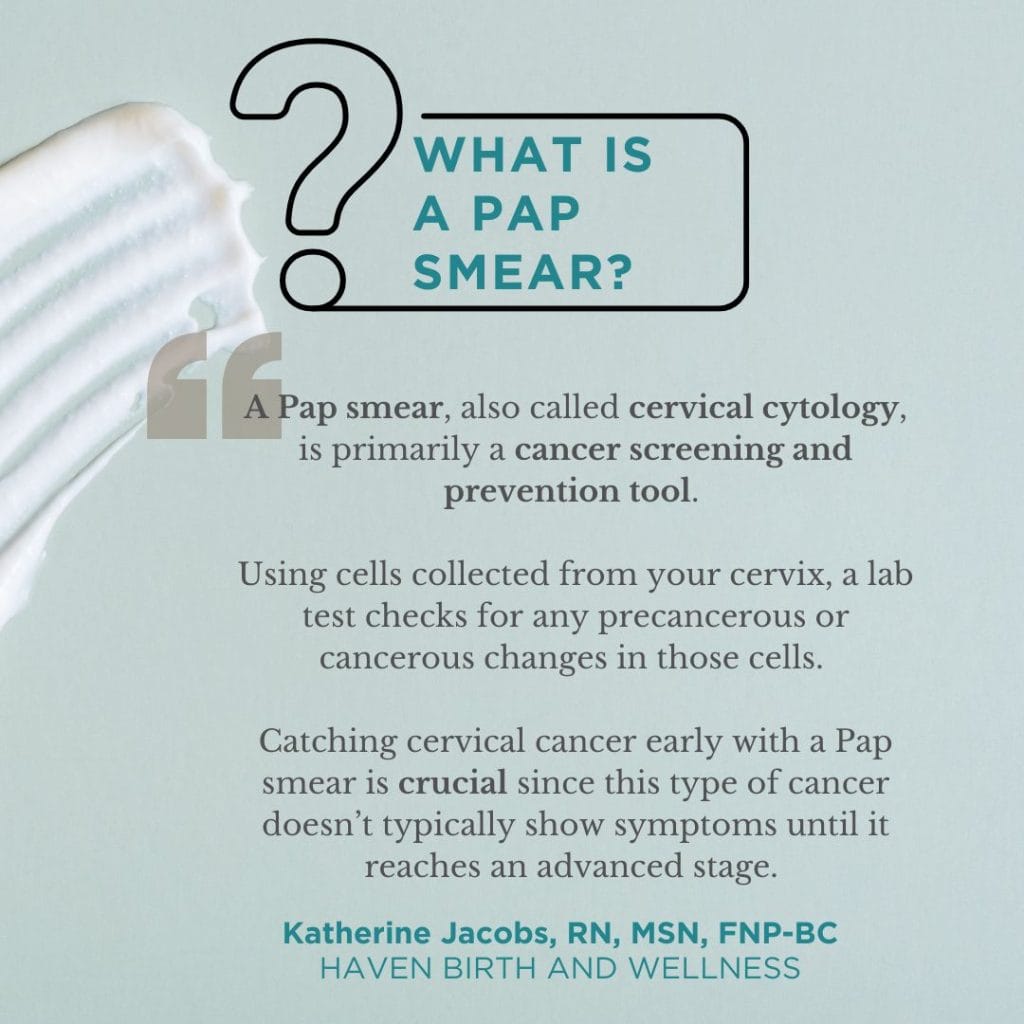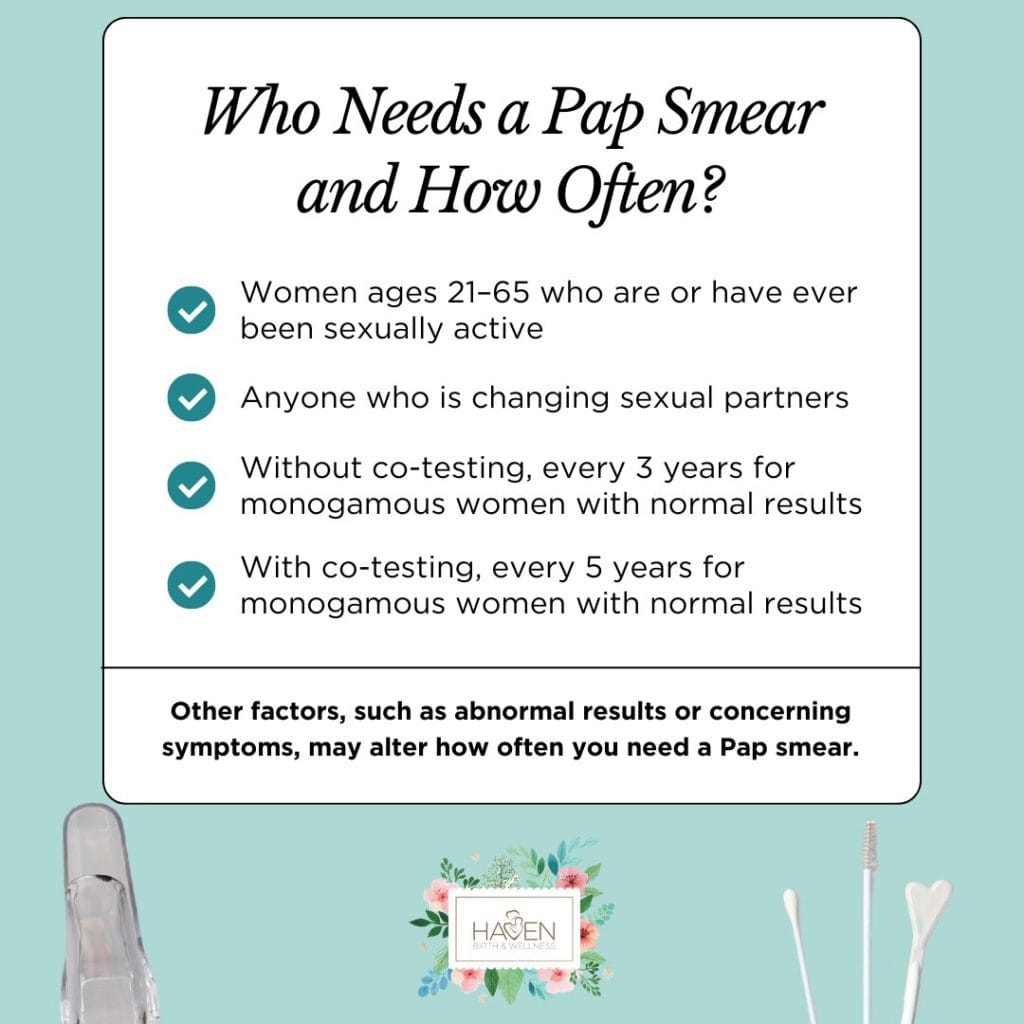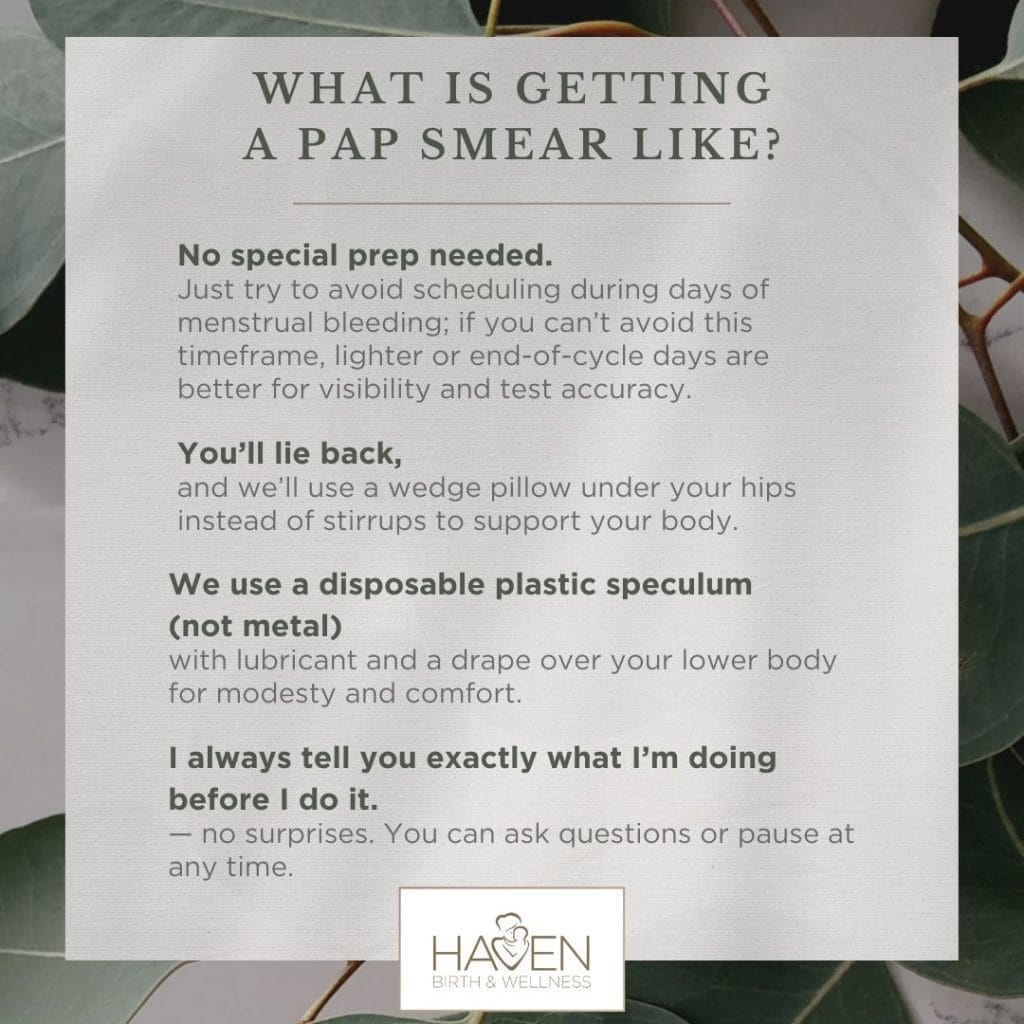

If you’ve never had a well-woman exam before — or you have, but you didn’t get a lot of explanation — you might be wondering what is a Pap smear?
Talking about this part of your health can feel vulnerable, and I’m glad you’ve taken the time to seek answers. Understanding your medical care is important and powerful, as is feeling supported and informed.
At Haven Birth and Wellness, we take a whole-person, gentle approach to care, and Pap smears are just one of the tools we use to support your long-term health and well-being. Below, I’ll walk through what a Pap smear is generally, as well as our practice’s particular approach.
What Is a Pap Smear?
First, what is a Pap smear? A Pap smear, also called cervical cytology, is primarily a cancer screening and prevention tool. Using cells collected from your cervix, a lab test checks for any precancerous or cancerous changes in those cells. Catching cervical cancer early with a Pap smear is crucial, since this type of cancer doesn’t typically show symptoms until it reaches an advanced stage.

In addition to cervical cytology, our practice also includes something called “co-testing.” Co-testing means that, along with screening for cellular changes, the lab looks for the presence of high-risk strains of human papillomavirus (HPV), a sexually transmitted virus that increases your risk for cervical cancer. Co-testing allows you to extend the time between Pap smears to 5 years, provided your results are normal and you haven’t changed partners. Without co-testing, you need screening at least every 3 years.
Co-testing is a thorough and effective way to understand what’s going on in your body, and we feel it should be part of standard practice. If you’re unsure whether your provider does co-testing, don’t hesitate to ask. It’s one of the best ways to get a complete picture of your cervical health.
Pap smears also provide an opportunity to test for other sexually transmitted infections (STIs), though most practices only perform this additional testing if you request it or if you have concerning symptoms. If you’re getting your Pap smear at Haven and want STI testing, just let us know.
What’s the Difference Between a Pelvic Exam and a Pap Smear?
Both a pelvic exam and a Pap smear involve using a speculum and light so your provider can see your cervix and the surrounding anatomy, like the vaginal wall, vaginal tissue, and any visible signs of irritation or inflammation.
A Pap smear always involves a pelvic exam, but you can have a pelvic exam without a Pap smear. However, I only perform independent pelvic exams if you have concerning symptoms.
At Haven, we only do a pelvic exam if you’re getting your Pap smear or if you have a specific concern like pelvic pain, abnormal bleeding, signs of prolapse, or signs of a yeast infection or bacterial vaginosis.
Why Are Pap Smears Important?
Pap smears are the best tool we have for catching cervical cancer early, when successful treatment is most likely. It’s similar to mammograms screening for breast cancer or colonoscopies looking for colon cancer. And, like colonoscopies, Pap smears even provide the opportunity for us to take preventative measures in the event of precancerous findings.
Co-testing can’t prevent or cure an HPV infection, but it can identify whether that virus is causing changes in your cervical cells. That gives us a critical head start in keeping you healthy.
If you’re sexually active or have had new or multiple partners, a Pap smear (perhaps alongside STI screening) also helps us spot signs of new viruses or bacteria that may have been introduced to your system.
Who Needs a Pap Smear and How Often?
At our practice, we follow evidence-based guidelines with a personalized lens. Here’s what that looks like:
- Pap smear screening for women ages 21–65 who are or have ever been sexually active
- Annual Pap smear for anyone who is changing partners
- Without co-testing, a Pap smear every 3 years for monogamous women with normal results
- With co-testing, a Pap smear every 5 years for monogamous women with normal results
Other factors, such as abnormal results or concerning symptoms, may alter how often you need a Pap smear:
- A past abnormal Pap smear may indicate a need for more frequent screening, depending on your results and risk level.
- If you’re having symptoms like abnormal bleeding, pain, or discharge, we’ll likely recommend a Pap smear and/or pelvic exam even if it’s ahead of your usual schedule.
- If you’re over 65 and have a history of normal Pap smear results, you likely no longer need them unless you’re in a higher-risk category.

Do You Need a Pap Smear After a Hysterectomy?
If you’ve had a hysterectomy, Pap smear recommendations vary:
- If your cervix was removed and you don’t have a history of abnormal findings, you probably don’t need Pap smears anymore.
- If you still have your cervix, or if you have any history of abnormal Pap smear results, we’ll recommend continued screening based on current guidelines.
What Is Getting a Pap Smear Like?
The idea of getting a Pap smear can bring up anxiety, especially if you’ve had past trauma or pelvic pain. At Haven, we honor your feelings, and we do everything we can to make the experience feel safe, calm, and gentle.
Here’s what to expect:
- No special prep needed. Just try to avoid scheduling during days of menstrual bleeding; if you can’t avoid this timeframe, lighter or end-of-cycle days are better for visibility and test accuracy.
- You’ll lie back, and we’ll use a wedge pillow under your hips instead of stirrups to support your body.
- We use a disposable plastic speculum (not metal), with lubricant and a drape over your lower body for modesty and comfort.
- I always tell you exactly what I’m doing before I do it — no surprises. You can ask questions or pause at any time.
We can dim the lights, use a white noise machine, and give you as much time as you need to breathe, relax, and feel safe. I often encourage patients to close their eyes and focus on deep breathing.
If you’ve experienced trauma, vaginismus, or pelvic pain, please let us know ahead of time. We’ll talk through it together and adjust anything we need to. Remember, you’re in control the entire time.

What Is a Pap Smear: Final Thoughts
So, what is a Pap smear? It’s more than just a test; it’s a powerful, proactive way to care for your health. It helps detect problems early, stay ahead of potential danger, and give you peace of mind.
We’re here to answer your questions, walk with you through every step, and provide care that’s as gentle as it is thorough. Whether it’s your first Pap smear or your fifteenth, we want you to feel safe, supported, and respected.
Your health matters, and so do you.

Katherine Jacobs is a board-certified Family Nurse Practitioner with nearly two decades (17 years) of experience in pediatrics and women's health, along with specialized training from The Institute of Functional Medicine. She focuses on identifying the root causes of illness and guiding patients toward optimal health through personalized, holistic care. With a commitment to integrating lifestyle choices and environmental factors into her treatment plans, Katherine is dedicated to empowering her patients on their wellness journeys. Outside of work, she enjoys outdoor adventures, baking, and spending time with her family.
